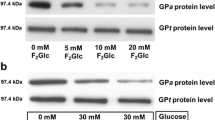Summary
The present paper describes an animal model of lysosomal glycogenosis as induced by a competitive inhibitor of α-glucosidase. Rats received intraperitoneal injections of the inhibitor, a pseudotetrasaccharide (Acarbose, Bay g 5421); liver tissue was examined by light and electron microscopy. Substrate-histochemical and enzyme-cytochemical methods were used to demonstrate intralysosomal glycogen storage within hepatocytes and Kupffer cells. The cytological picture closely resembled that occurring in glycogenosis type II (Pompe’s disease) of humans. After cessation of drug treatment, the glycogen storage was slowly reversible. The present results point to the physiological role of the lysosomal apparatus for intracellular glycogen turnover. On the cellular level, this experimentally induced glycogenosis may be useful as a model of Pompe’s disease.
Similar content being viewed by others
References
Barka T, Anderson PJ (1962) Histochemical methods for acid phosphatase using hexazonium pararosanilin as coupler. J Histochem Cytochem 10:741–753
Baudhuin P, Hers, HG, Loeb H (1964) An electron microscopic and biochemical study of type II glycogenosis. Lab Invest 13:1139–1152
Brown DH, Brown BI, Waindle LM (1980) Studies on the lysosomal degradation of glycogen in cultured human skin fibroblasts. In: Marshall J J (ed) Mechanisms of saccharide polymerization and depolymerization. Academic Press, New York, pp 187–208
Brown DH, Waindle LM, Brown BI (1978) The apparent activity in vivo of the lysosomal pathway of glycogen catabolism in cultured human skin fibroblasts from patients with type III glycogen storage disease. J Biol Chem 253:5005–5011
Deams WT, Wisse E, Brederoo P (1969) Electron microscopy of the vacuolar apparatus. In: Dingle JT, Fell HB (eds) Lysosomes in biology and pathology, vol. 1. North-Holland, Amsterdam, pp 64–112
Doty SB, Smith CE, Hand AR, Oliver C (1977) Inorganic trimetaphosphatase as a histochemical marker for lysosomes in light and electron microscopy. J Histochem Cytochem 25:1381–1384
Geddes R, Stratton GC (1977) The influence of lysosomes on glycogen metabolism. Biochem J 163:193–200
Hers HG (1963) α-Glucosidase deficiency in generalized glycogen-storage disease (Pompe’s disease). Biochem J 86:11–16
Hers HG, de Barsy T (1973) Type II glycogenosis (acid maltase deficiency). In: Hers HG, Van Hoof F (eds) Lysosomes and storage diseases. Academic Press, New York, pp 197–216
Hug G (1979) Preand postnatal pathology, enzyme treatment, and unresolved issues in five lysosomal disorders. Pharmacol Rev 30:565–591
Hug G, Schubert WK (1967) Glycogenosis type II. Arch Pathol 84:141–152
Jézéquel AM, Arakawa K, Steiner JW (1965) The fine structure of the normal, neonatal mouse liver. Lab Invest 14:1894–1930
Lloyd JB (1973) Experimental support for the concept of lysosomal storage disease. In: Hers HG, Van Hoof F (eds) Lysosomes and storage diseases. Academic Press, New York, pp 173–195
Lüllmann-Rauch R (1981) Lysosomale Glycogenspeicherung in verschiedenen Organen der Ratte nach Behandlung mit einem α-Glucosidase-Hemmstoff. Anat Anz 149:94
Maunsbach AB, Madden SC, Latta H (1962) Light and electron microscopic changes in proximal tubules of rats after administration of glucose, mannitol, sucrose, or dextran. Lab Invest 11:421–432
Meijer AEFH, Willighagen RGJ (1963) The activity of glucose-6-phosphatase, adenosine triphosphatase, succinic dehydrogenase, and acid phosphatase after dextran or polyvinylpyrrolidone uptake by liver in vivo. Biochem Pharmacol 12:973–980
Monserrat AJ, Gotelli C, Garay R (1969) Sequential histochemical features in experimental osmotic nephrosis. Virchows Arch [Cell Pathol] 3:365–376
Munger BL (1961) Staining methods applicable to sections of osmium-fixed tissue for light microscopy. J Biophys Biochem Cytol 11:502–506
Padilla SS, Burrill PH, Sidbury JB (1981) Studies with a new competitive inhibitor of α-glucosidases. Proc Am Soc Ped Res 1.-5. V, San Francisco, Abstr No 1170
Pfeifer U (1970) Celluläre Autophagie: Glykogensegregation im Frühstadium einer partiellen Leberatrophie. Virchows Arch [Cell Pathol] 5:242–253
Pfeifer U (1971) Tageszeitliche Rhythmik der zellulären Autophagie insbesondere der Glykogensegregation in Leberepithelien unbehandelter Ratten. Naturwissenschaften 58:152
Phillips MJ, Unakar J, Doornewaard G, Steiner JW (1967) Glycogen depletion in the newborn rat liver. An electron microscopic and electron histochemical study. J Ultrastruct Res 18:142–165
Postma DS, Logue S, Pecorak JB, Prazma J (1978) Histochemistry of glycogen in the inner ear. Histochem J 10:53–61
Pütter J (1980) Studies on the pharmacokinetics of Acarbose in humans. In: Brodbeck U (ed) Enzyme inhibitors. Verlag Chemie, Weinheim, pp 139–151
Puls W, Keup U, Krause HP, Müller L, Schmidt DD, Thomas G, Truscheit E (1980) Pharmacology of a glucosidase inhibitor. Front Hormone Res 7:235–247
Puls W, Keup U, Krause HP, Thomas G, Hoffmeister F (1977) Glucosidase inhibition. A new approach to the treatment of diabetes, obesity, and hyperlipoproteinaemia. Naturwissenschaften 64:536–537
Rybicka K (1979) Glycosomes (protein-glycogen complex) in the canine heart. Virchows Arch [Cell Pathol] 30:335–347
Sachse G, Willms B (1979) Effect of the α-glucosidase-inhibitor Bay-g-5421 on blood glucose control of sulphonylurea-treated diabetics and insulin-treated diabetics. Diabetologia 17:287–290
Schmidt DD, Frommer W, Junge B, Müller L, Wingender W, Truscheit E, Schäfer D (1977) α-Glucosidase inhibitors. New complex oligosaccharides of microbial origin. Naturwissenschaften 64:535–536
Silverstein SC, Steinman RM, Cohn ZA (1977) Endocytosis. Ann Rev Biochem 46:669–722
Trump BF, Janigan DT (1962) Pathogenesis of cytologic vacuolization in sucrose nephrosis. Lab Invest 11:395–411
Vye MV, Fischman DA (1970) The morphological alteration of particulate glycogen by en bloc staining with uranyl acetate. J Ultrastruct Res 33:278–291
Wattiaux R, Wattiaux-De Coninck S, Rutgeerts MJ, Tulkens P (1964) Influence of the injection of a sucrose solution on the properties of rat-liver lysosomes. Nature 203:757–758
Author information
Authors and Affiliations
Rights and permissions
About this article
Cite this article
Lüllmann-Rauch, R. Lysosomal glycogen storage mimicking the cytological picture of Pompe’s disease as induced in rats by injection of an α-glucosidase inhibitor. Virchows Archiv B Cell Pathol 38, 89–100 (1981). https://doi.org/10.1007/BF02892805
Received:
Accepted:
Issue Date:
DOI: https://doi.org/10.1007/BF02892805




